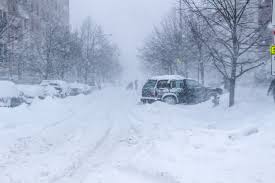Blizzard:

A severe blizzard struck the eastern face of Mount Everest in Tibet, trapping nearly 1,000 trekkers in the remote Karma valley.
- A blizzard is a severe mid-latitude snowstorm characterized by strong winds (≥56 km/h), low temperatures, and near-zero visibility caused by blowing snow.
- It occurs when polar or continental cold air masses interact with moist maritime or tropical air, producing intense snowfall accompanied by violent winds.
It Develops:
- Cold, dense air from high latitudes or elevated terrain ensures snow formation instead of rain.
- Moist air masses, often from nearby oceans or large lakes, provide water vapour for condensation and precipitation.
- Warm, moist air is forced to rise over cold air (frontal uplift) or up mountain slopes (orographic uplift), forming snow-laden clouds.
- A steep pressure difference generates high wind speeds, driving snow horizontally and drastically reducing visibility.
Features:
- Wind Velocity: 80–100 km/h (often exceeding 120 km/h in severe cases).
- Temperature: Falls below freezing, intensifying wind chill effects.
- Visibility: Drops below 0.4 km for over three hours, leading to whiteout conditions.
- Duration: Can persist for several hours to days, often followed by cold wave conditions.
Variants:
- Ground Blizzard: Pre-existing snow lifted by strong winds.
- Nor’easter: Coastal blizzard type common along North Atlantic coasts.
Impact:
- Causes snow accumulation, avalanches, and temporary glacial expansion.
- Alters albedo and local energy balance, affecting regional climate feedbacks.




